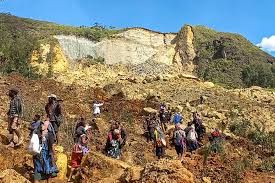In a heart-wrenching announcement, a Papua New Guinea government official informed the United Nations that last Friday’s catastrophic landslide has likely buried more than 2,000 people alive. This tragic event has prompted an urgent call for international aid as the nation grapples with one of its most devastating natural disasters.
The Scale of the Tragedy
A Sudden and Deadly Disaster
The landslide struck the mountainous interior of Papua New Guinea, specifically in the Yambali village in Enga province. The scale of the disaster is staggering, with the government’s estimate of casualties being roughly triple the United Nations’ initial estimate of 670 people.
Conflicting Reports on Casualties
Local authorities reported that by Monday, the remains of only five individuals had been recovered. This figure was a revision from the previously reported six casualties, reflecting the ongoing challenges in accurately assessing the full impact of the landslide.
Government and International Response
Appeal for International Aid
Luseta Laso Mana, the acting director of the National Disaster Center, formally requested international assistance in a letter to the United Nations resident coordinator. The letter described the landslide’s catastrophic impact and the urgent need for aid to manage the aftermath and rescue operations.
Challenges in Rescue Operations
The rugged and remote terrain of the affected area has made rescue operations exceedingly difficult. The immediate focus is on locating survivors, recovering bodies, and providing relief to those displaced by the disaster.
Community Impact
Devastation in Yambali Village
The Yambali village has been decimated, with the landslide causing extensive destruction. The local community, now reeling from the loss of loved ones and homes, faces a long road to recovery.
Humanitarian Concerns
Beyond the immediate need for rescue and recovery, there are significant humanitarian concerns. Thousands of people are now without shelter, food, and basic necessities. The psychological toll on survivors and the broader community cannot be understated.
Natural Disaster Preparedness
Assessing Vulnerability
Papua New Guinea’s rugged landscape makes it particularly susceptible to natural disasters such as landslides. This tragic event underscores the importance of assessing and mitigating such vulnerabilities to better protect communities in the future.
Improving Early Warning Systems
Enhanced early warning systems and better infrastructure are crucial in reducing the impact of natural disasters. There is an urgent need for investment in these areas to prevent similar tragedies.
Environmental Factors
Triggering the Landslide
The specific environmental factors that triggered this landslide are still under investigation. However, heavy rainfall and geological instability are likely contributors. Understanding these factors is essential for future disaster prevention.
Climate Change Considerations
Climate change is increasing the frequency and severity of extreme weather events globally. This landslide may be a stark reminder of the broader impacts of climate change, necessitating more robust environmental and disaster management policies.
Global Solidarity
International Aid and Support
The global community’s response to Papua New Guinea’s call for help will be critical. International aid can provide the resources needed for immediate relief and long-term recovery efforts.
Building Resilient Communities
Beyond immediate aid, there is a need for sustained international cooperation to build resilient communities. This involves infrastructure development, capacity building, and support for sustainable development practices.
Rescue Efforts and Challenges
Current Rescue Operations
Rescue teams are working tirelessly under challenging conditions to find survivors and recover the deceased. The difficult terrain and ongoing risks of further landslides complicate these efforts.
Support for Rescue Workers
Rescue workers themselves face significant risks and psychological strain. Providing support and resources for these teams is essential to maintain the effectiveness and safety of ongoing operations.
Economic Impact
Damage to Infrastructure
The landslide has caused extensive damage to local infrastructure, including roads, homes, and public facilities. Rebuilding efforts will require significant investment and international assistance.
Long-Term Economic Consequences
The economic impact of this disaster will be felt for years to come. Disrupted livelihoods, loss of homes, and the cost of rebuilding will place a heavy burden on the affected communities and the national economy.
Human Stories
Survivors’ Accounts
Personal stories of survival and loss are emerging from the tragedy. These accounts highlight the human aspect of the disaster, bringing to light the resilience and strength of those affected.
Community Resilience
Despite the immense challenges, the community’s resilience and solidarity are evident. Local efforts to support one another and rebuild are inspiring and underscore the importance of community in disaster recovery.
Future Preparedness
Lessons Learned
This disaster offers critical lessons in preparedness and response. Evaluating what worked and what didn’t can help improve future disaster management strategies.
Strengthening Infrastructure
Investing in resilient infrastructure and better urban planning can mitigate the impact of future natural disasters. This includes building landslide-resistant structures and enhancing drainage systems.
The landslide in Papua New Guinea is a tragedy of immense proportions, with over 2,000 lives feared lost and countless others affected. The response to this disaster requires immediate international aid and long-term commitment to rebuilding and improving resilience. As the world watches, the solidarity and support from the global community will be crucial in helping Papua New Guinea recover from this devastating event




